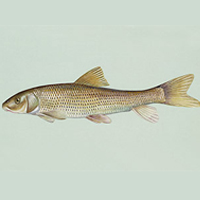Spotted sucker
Scientific name: Minytrema melanops

Cover photo credit: US Fish and Wildlife Service
Status
Special Concern
“Special Concern” means the species lives in the wild in Ontario, is not endangered or threatened, but may become threatened or endangered due to a combination of biological characteristics and identified threats.
Date added to the Species at Risk in Ontario List
The Spotted sucker was already assessed as a species of special concern when the Endangered Species Act took effect in 2008. It was re-assessed as special concern in 2015.
Read the report (PDF)
What it looks like
This freshwater fish grows to an average length of 22 to 38 centimetres and can weigh up to 1.3 kilograms. It has distinctive square, brown-black spots on the base of each scale. These are more conspicuous on the sides of the body, appearing as eight to 10 rows of spots along the body. The sides are mostly bronze, coppery or silvery with white or silver undersides. The dorsal, caudal and anal fins are olive grey and other fins are dusky to white.
Where it lives
The Spotted sucker usually inhabits clear creeks and small to moderate sized rivers with sand, gravel or hard-clay bottoms, usually free of silt. However, in Ontario it has frequently been found in turbid habitats. In late spring and early summer, Spotted suckers move to rocky riffle areas of streams to breed.
Where it’s been found in Ontario
The Spotted sucker range is restricted to the fresh waters of eastern and central North America from the lower Great Lakes east to Pennsylvania, south to the Gulf Coast and Florida, and west to Texas. In Canada, this species is limited to southwestern Ontario, where it is found in Lake St. Clair and western Lake Erie as well as the Detroit, St. Clair, Sydenham and Thames rivers.
View a larger version of this map (PDF)
What threatens it
Habitat degradation, pollution, siltation and dams are detrimental to the well being of the Spotted sucker. The Ontario population represents the northern limits for the species so it may always have been rare here.
Action we are taking
Special concern species do not receive species or habitat protection.
What you can do
Report a sighting
- Report a sighting of an endangered animal or plant to the Natural Heritage Information Centre. Photographs with specific locations or mapping coordinates are always helpful.
Volunteer
Volunteer with your local nature club or provincial park to participate in surveys or stewardship work focused on species at risk.
Be a good steward
- private land owners have a very important role to play in species recovery; you may be eligible for stewardship programs that support the protection and recovery of species at risk and their habitats
- land owners can help improve fish habitat and keep Ontario’s water safe and clean by maintaining natural vegetation next to creeks and rivers, and keeping pollution and soil from washing into Ontario’s rivers; you can find more information about programs and funding assistance for eligible farmers from the Ontario Soil and Crop Improvement Association website
Report illegal activity
Report any illegal activity related to plants and wildlife to
Quick facts
- Spotted sucker was not observed in Canada until 1962, when it was captured by a commerical fisherman in Lake St. Clair
- young Spotted suckers do not have the distinctive spotting pattern, making it difficult to distinguish from White Suckers and similar redhorse species
- the Spotted sucker has no teeth in its mouth, but rather has comb-like teeth in its throat (as do most sucker species), which it uses to feed on molluscs and immature aquatic insects
